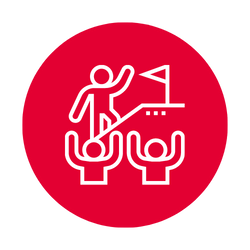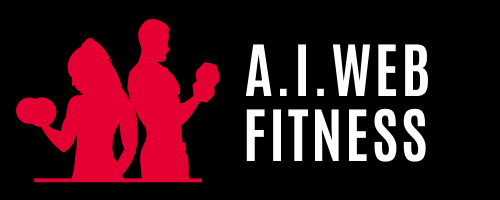I Partner with dedicated Personal Trainers like YOU – GROW Your Clients.
> Go Online >> Get More Clients >>> Get Results!
FITNESS WEBSITE STRATEGY:
COPY - DESIGN - BRAND - SEO PERFECTION.

You are a Fitness Trainer. That's awesome!
Would you love to know how to get online training clients?
As a fitness trainer, you understand how important it is to attract new clients and make your business grow.
But with so many other trainers out there, it can be really tough.
It’s like a survival competition in the fitness world.

Competition
You meet fierce competition online, making it hard to stand out.

Time
You juggles with clients across time zones & crafting online content, is time-consuming.

Clients
You feel that progress is slow and discouraging and gaining clients is tough.

Technical
You lack skills in video creation, web development, and social media marketing.

Budget
You find it hard to balance marketing, website costs, and other expenses.
So, how can you find your way through all this fitness chaos and not get lost?
Getting all the help you can will be really useful!
These 4 PROVEN STEPS could finally be what you been looking for!
Numerous fitness experts, including Ross Dickerson, Justin Gelband, Nick Mitchell, Aaron Williamson, Alexia Clark, and others, have employed these 4 proven steps to reach the heights of success and recognition they enjoy today.
Develop
Design
Construct
Scale
Here's How It Is Done and It's Tailored Made Just For You!
A.I.powered -

A.I.powered -
02- DESIGN
Keywords Research & Related SEO Activities -
Design Your Logo -
Create Your Style Guide -
Build Page Layouts & Wireframes -
Design Web Pages -
Prepare Pages For Development -
Design Lead Capture Pages -

A.I.powered -
03- CONSTRUCT
- Setup Your Website Platform
- Setup Your Web Host
- Add Your Custom Domain
- Secure Your Website
- Install Your Theme
- Install Your Plugins
- Build Web Pages
- Create Page Templates
- Build Your Navigation Menu
- Build Lead Capture Forms
- Protect Your Content
- Create Memberships
- Accept & Process Payments
- Embed Your Videos

A.I.powered -
04- SCALE
Setup Social Media Marketing -
Schedule Your Posts -
Setup Email Marketing -
Create Email Campaigns -
Launch Ad Campaigns -
Expand & Scale Your Business -

Here's what you get!

Maximized Online Potential
Elevate your fitness business with:
- A visually striking and high-performing website.
- Social Media Engagements.
- Converting web copy.
- SEO that drives targeted leads and clients to your site.
- Membership program for your clients.
- And so much more…

Amplify Client Engagement
Build strong client relationships with:
- Appointment Scheduling.
- Class Registration.
- Membership Videos.
- Client Portal.

Seamless User Experience
Experience user-friendly website that provides a quick and effortless access.
Ensure visitors to easily find what they need and become your loyal customers.

Mobile-Optimized and Responsive
- Capture users on the go with a sleek, device-friendly personal trainer website that offers seamless interaction.

Tailored Solutions
-
Be unique as a fitness trainer.
Provide customized web solutions to strengthen your brand, attract quality clients, and foster growth.

Showcase Expertise
-
Instill trust and impress visitors with a website that highlight your expertise and success.
Be the preferred choice, in your local market as a fitness expert.
What is being done differently?
You get customized solutions that caters to your unique needs and sets your business apart.

Specialized Expertise
- Highlight Your Fitness Industry Expertise.
- Meet Trainee Needs.
- Establish Credibility as a Niche Expert.

Holistic Approach
Experience all-in-one online solutions:
- Website Design.
- SEO.
- Social Media Integration.
- Online Booking.
- Web Analytics.
- Ongoing Maintenance.

Artificial Intelligence Driven
AI improves fitness and wellness by providing:
- Personalized Training.
- Targeted Marketing.
- Automating Repetitive Tasks.
- Saves Time and Resources.
- Enhance Client Experience.

Results-Driven Approach
Experience tangible results by leveraging:
- The Power of Story Telling.
- Testimonials.
- Leads Generation.
- Search Engine Optimization.
- Email Marketing.
- Social Media Engagement.

Personalized Solutions
Achieve your fitness business goals with personalized solutions.
Showcase your brand identity through customized websites and marketing strategies.
How to get online training clients with AI technology?
AI technology can be a valuable asset for fitness trainers in planning, designing, launching, and scaling their online business. Here’s how:
Develop:
AI technology helps fitness trainers brainstorm ideas, identify their target audience, and develop a strategic roadmap.
By leveraging AI tools, trainers can clarify goals, define their unique value, and create a comprehensive plan.
Design:
AI technology aids fitness trainers in designing their online presence, offering guidance on website aesthetics, user experience, and branding.
It also assists in creating engaging content across various platforms to effectively communicate expertise and engage the audience.
Construct:
AI technology assists fitness trainers in launching their online business, advising on platform selection, e-commerce setup, and payment integration.
AI-powered analytics aid in creating successful launch strategies, including promotions, lead generation, and customer acquisition.
Scale:
As fitness trainers grow their online business, AI technology becomes invaluable. It provides insights on expanding offerings, optimizing pricing, and implementing automation.
AI algorithms guide customer retention, community building, and data-driven decision-making for business growth and getting more online personal training clients.
Expert Advice:
AI technology can act as a virtual mentor, offering industry insights, best practices, and the latest trends in the fitness and online business space.
Trainers can leverage AI-powered tools to ask questions, seek guidance on overcoming challenges, and receive personalized recommendations to stay ahead of the competition.
Fitness trainers should utilize AI as a tool to augment their skills and knowledge.
At the same time, seek guidance from experienced professionals in the fields of marketing, web development, and business strategy to ensure a well-rounded approach to your online business journey.
If you are in one or more of the following categories:
- Strength and Conditioning Coach
- CrossFit Coach
- Functional Training Specialist
- Weightlifting Coach
- Bodybuilding Trainer
- Sports Specific Trainer
- Sports Performance Coach
- Functional Fitness Coach
- Strength and Powerlifting Coach
- Personal Trainer
- Group Fitness Instructor
- Aerobics Instructor
- Dance Fitness Instructor
- Cycling Instructor
- Bootcamp Instructor
- Circuit Training Instructor
- Piloxing Instructor
- Dance Cardio Instructor
- Group Strength Training Instructor
- Boxing Fitness Trainer
- Personal Trainer
- Group Fitness Instructor
- Aerobics Instructor
- Dance Fitness Instructor
- Cycling Instructor
- Bootcamp Instructor
- Circuit Training Instructor
- Piloxing Instructor
- Dance Cardio Instructor
- Group Strength Training Instructor
- Boxing Fitness Trainer
- Strength and Conditioning Coach
- CrossFit Coach
- Functional Training Specialist
- Weightlifting Coach
- Bodybuilding Trainer
- Sports Specific Trainer
- Sports Performance Coach
- Functional Fitness Coach
- Strength and Powerlifting Coach
- Personal Trainer
- Group Fitness Instructor
- Aerobics Instructor
- Dance Fitness Instructor
- Cycling Instructor
- Bootcamp Instructor
- Circuit Training Instructor
- Piloxing Instructor
- Dance Cardio Instructor
- Group Strength Training Instructor
- Boxing Fitness Trainer
If you don’t find your category here, reach out to me. I will be honored to help you out.
- Yoga Instructor
- Pilates Instructor
- Mind-Body Wellness Coach
- Mindfulness and Meditation Instructor
- Wellness Coach
- Mind-Body Integration Coach
- Tai Chi Instructor
- Rehabilitation Specialist
- Corrective Exercise Specialist
- Post-Rehabilitation Trainer
- Injury Prevention Specialist
- Rehabilitation Specialist
- Corrective Exercise Specialist
- Post-Rehabilitation Trainer
- Injury Prevention Specialist
- Yoga Instructor
- Pilates Instructor
- Mind-Body Wellness Coach
- Mindfulness and Meditation Instructor
- Wellness Coach
- Mind-Body Integration Coach
- Tai Chi Instructor
- Athletic Trainer
- Martial Arts Instructor
- Senior Fitness Specialist
- Pre- and Postnatal Fitness Trainer
- Aqua Fitness Instructor
- TRX Suspension Trainer
- TRX Rip Trainer
- Sports Nutrition Coach
- Weight Management Coach
- Core Strengthening Specialist
- Youth Fitness Trainer
- Senior Exercise Specialist
- Sports Psychology Consultant
- Balance and Stability Coach
- Flexibility and Mobility Instructor
- Speed and Agility Coach
- Functional Medicine Fitness Coach
- Holistic Fitness Trainer
- Dance Technique Trainer
- Mindful Movement Instructor
- Outdoor Fitness Instructor
- Wellness Retreat Facilitator
- Wellness Program Coordinator
- Mindset and Motivation Coach
- Functional Medicine Fitness Coach
- Holistic Fitness Trainer
- Dance Technique Trainer
- Mindful Movement Instructor
- Outdoor Fitness Instructor
- Wellness Retreat Facilitator
- Wellness Program Coordinator
- Mindset and Motivation Coach
- Athletic Trainer
- Martial Arts Instructor
- Senior Fitness Specialist
- Pre- and Postnatal Fitness Trainer
- Aqua Fitness Instructor
- TRX Suspension Trainer
- TRX Rip Trainer
- Sports Nutrition Coach
- Weight Management Coach
- Core Strengthening Specialist
- Youth Fitness Trainer
- Senior Exercise Specialist
- Sports Psychology Consultant
- Balance and Stability Coach
- Flexibility and Mobility Instructor
- Speed and Agility Coach
I Am Waiting For YOU!

My finished works
Customer Reviews
“I can’t thank Richerd enough for his exceptional web consulting services.
He not only designed a stunning website for me but also provided valuable insights on SEO and content strategy.
My website now ranks higher in search results, and I’ve gained more visibility in my local area.”
“Richerd’s expertise in web consulting has been invaluable in establishing my online brand.
He helped me develop a website that not only looks great but also effectively showcases my services.
Thanks to his guidance, I’ve been able to reach a wider audience and grow my client base.”

His attention to detail and creative approach helped me create a captivating online presence.
I’ve received numerous compliments from clients and colleagues on my website’s design and functionality.”
“Richerd’s experience and knowledge in web consulting has been instrumental in taking my fitness business to the next level.
He provided valuable guidance on branding, layout, and content creation, which helped me establish a professional online presence and attract new clients.”
“I am incredibly grateful for Richerd’s web consulting expertise.
He transformed my outdated website into a sleek and professional platform that represents my fitness training services accurately.
Thanks to his guidance, I’ve seen an increase in client inquiries and bookings.”
“Richerd has been an invaluable asset to my fitness training business.
His expertise in web consulting has allowed me to create a professional website that showcases my services and expertise.
I appreciate his prompt communication, attention to detail, and commitment to delivering exceptional results.
I highly recommend him to any fitness professional looking to enhance their online presence.”
Ready to take your fitness business to new heights?
Imagine developing a robust online presence that showcases your expertise and enhances your visibility, foster genuine client connections and differentiate from competitors.
Expand your client base and establish yourself as an expert, while achieving a harmonious work-life balance. Fulfill your motivation and help clients achieve their fitness goals.
Let’s revolutionize your business and create a success story that inspires others. I hope by now you know the answer on how to get more online fitness clients.

FAQ
I offer a range of services to personal fitness trainers including website design, website optimization, search engine optimization, social media marketing, and general web consulting services.
I offer a range of services to personal fitness trainers including website design, website optimization, search engine optimization, social media marketing, and general web consulting services.
I can help get more online fitness clients by creating a website that showcases your skills and services, optimizing your website for search engines, and creating and implementing a social media marketing strategy that targets your desired audience.
I have worked with personal fitness trainers in the past, helping them improve their online presence and reach a wider audience through effective web design and marketing strategies.
I offer both website design and consulting services, so I can create a website for you from scratch or work with you to improve your existing website.
The time it takes to create a website depends on several factors, including the complexity of the design and the amount of content that needs to be created. Generally, I can create a website within 4-6 weeks.
Yes, I design all websites to be mobile-friendly and responsive, meaning they will look great and function well on all devices, including smartphones and tablets.
Yes, I can help optimize your website for search engines by implementing effective SEO strategies, including keyword research, on-page optimization, and link building.
Yes, I offer social media marketing services for personal fitness trainers, including creating and managing social media accounts, developing content, and running paid advertising campaigns
My services are customized to meet the unique needs of each personal fitness trainer, so the cost can vary depending on the specific services required.
I offer competitive pricing and will provide a detailed quote once I have a better understanding of your needs.
Yes, I can provide references and examples of other personal fitness trainers I have worked with upon request.
I am proud of my portfolio and my happy clients, and I’m always happy to share my work with potential clients.
Yes, I can help you integrate online scheduling or booking systems into your website, making it easy for your clients to book appointments with you online.
I can help you increase the number of leads and clients for your personal training business by creating a website and marketing strategy that effectively targets your ideal audience.
I can also help you develop lead generation tactics and implement email marketing campaigns.
Yes, I can help you develop and implement an e-commerce strategy for your fitness products, including creating an online store, integrating payment gateways, and developing marketing campaigns to promote your products.
Yes, I offer website maintenance and support services to ensure your website is always up-to-date, secure, and functioning properly. I also offer technical support to help you troubleshoot any issues that may arise.
My process for working with personal fitness trainers typically involves an initial consultation to discuss your needs and goals, followed by a proposal outlining our recommended services and pricing.
Once I have agreement on the project, I will begin the design and development process and provide regular updates and progress reports.
Once the website is completed, I will provide training on how to use and manage your website, as well as ongoing support and maintenance.
Yes, I can help you develop a content strategy that aligns with your goals and targets your ideal audience. I can also help you create high-quality content, including blog posts, videos, and social media posts, to attract and engage your audience.
Yes, I can help you develop a content strategy that aligns with your goals and targets your ideal audience.
I can also help you create high-quality content, including blog posts, videos, and social media posts, to attract and engage your audience.
I can help you improve the user experience on your website by optimizing the design and layout, making it easy to navigate, and ensuring that it loads quickly and functions well on all devices.
Yes, I offer branding services to help you develop a strong brand identity that reflects your values and unique selling proposition.
I can help you create a logo, brand colors, and other branding materials.
Yes, I can help you develop and implement email marketing campaigns to promote your services, products, and events.
I can also help you grow your email list and segment your audience for better targeting.
I measure the success of our web consulting services by tracking key performance indicators such as website traffic, conversion rates, and engagement metrics.
I also solicit feedback from our clients to ensure that they are satisfied with the results and the overall experience of working with us.
Yes, I offer SEO services to help improve the visibility and ranking of your website on search engines like Google.
This can help drive more traffic to your website and increase your overall online presence.
Yes, I can help you integrate social media into your website by adding social media buttons, feeds, and sharing options.
I can also help you develop a social media strategy that complements your website and overall marketing efforts.
Yes, I offer website hosting services to ensure that your website is securely and reliably hosted on high-performance servers.
I also offer regular backups and maintenance to ensure your website runs smoothly.
Yes, I can help you create a mobile app for your personal training business that can improve engagement with your clients and offer additional services like in-app purchases or scheduling.
Yes, I offer website redesign services to improve the appearance, functionality, and user experience of your existing website.
Yes, I can help you create online courses or digital products related to fitness by providing web design, development, and e-commerce solutions to help you launch your products.
Yes, I can help you integrate third-party software, like payment gateways or membership platforms, into your website to offer additional services or functionality to your clients.
Yes, I offer training or consulting services to help you learn how to manage your website, including content updates, software updates, and basic troubleshooting. I can also provide ongoing support as needed.
Yes, I can help you with website analytics and reporting to track the performance of your website and marketing efforts.
This can include setting up tracking tools like Google Analytics and creating regular reports to monitor your progress.
I have advanced tools like ChatGpt 4, Midjourney 5.1, Canva, Photoshop, AI kit for WordPress and several other AI-powered solutions to make your online success a reality.
My passion lies in using these tools to help you excel in the digital world and achieve your online goals with ease.
This website is a masterpiece created with advanced technology and WordPress.
It has an attractive design, rich multimedia elements, and updated content. Users enjoy a seamless browsing experience.





